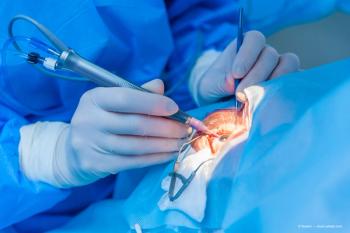
Due to the extraordinarily high volume and minimal surgeon time, the average cataract cost-including IOL choice-ranges from $41 to $125 at India’s Aravind Eye Hospital, said David W. Hutton.

Due to the extraordinarily high volume and minimal surgeon time, the average cataract cost-including IOL choice-ranges from $41 to $125 at India’s Aravind Eye Hospital, said David W. Hutton.

Substituting generic products for brand name innovators in cataract surgery medication regimens can bring trade-offs in efficacy, safety, and convenience, perhaps with just modest savings in cost.

Based on unknown preoperative anatomic considerations, efficacy, and safety data, phacotrabeculectomy may be a better option than phacoemulsification alone or combined with a microincision glaucoma surgical procedure in eyes with advanced glaucoma needing cataract surgery and low IOP.

Perioperative intracameral antibiotics should be standard practice during cataract surgery to prevent postoperative endophthalmitis.

In a multicenter phase II study of cataract surgery patients, recipients of a dexamethasone-releasing punctum plug (Ocular Therapeutix) were significantly more likely than their vehicle-treated counterparts to be free of pain and anterior chamber cells at various postoperative follow-up visits.

A retrospective analysis including data from a consecutive series of 1575 eyes shows that intravitreal placement of triamcinolone/moxifloxacin during cataract surgery is a safe and effective method for preventing inflammation, endophthalmitis, and cystoid macular edema.

Understanding why ophthalmologists should be using intracameral antibiotics to lower the risk of postoperative endophthalmitis after cataract surgery.

Three-dimensional (3D) visualization and guidance may be the future of lens IOL implantation. Douglas Koch, MD, posed two questions: Can surgeons eliminate marking for toric IOLs and eliminate the oculars on the microscope as well?

Following cataract surgery, patients can present with a variety of visual complaints that interfere with vision after IOL implantation. Negative dysphotopsias are relative and absolute scotomas, according toJack T. Holladay, MD.

Patients have high expectations regarding cataract surgery outcomes, and anything less than perfect may be considered a failure, said Kendall E. Donaldson, MD, MS.

An ophthalmologist compares two currently available fluidics systems and their ability to recover after occlusion is interrupted.

This month’s simultaneous meeting of the American Society of Cataract and Refractive Surgery and American Society of Ophthalmic Administrators will convene in Boston from April 25 to 29.

A newly introduced reusable injector system simplifies delivery and placement of a glistening-free, hydrophobic acrylic IOL in the experience of one ophthalmologist.

Complete removal of lens substance is critical in pediatric cataract surgery. M. Edward Wilson, MD, offers helpful strategies.

With the next step in cataract surgery, femtosecond laser-assisted cataract surgery, it is important to education physicians, staff members, and patients on the technology.

Thorough treatment of the ciliary processes-combined with measures for minimizing postoperative IOP spikes and inflammation-will lead to improved outcomes when performing endoscopic cyclophotocoagulation with cataract surgery.

The combination of two microinvasive glaucoma surgeries with cataract surgery may address a patient’s cataract and glaucoma in one procedure.

Endoscopy during cataract surgery improves visualization during nearly all steps of the procedure in eyes with an opaque cornea.

In a randomly assigned study, including 487 eyes with a leaking clear corneal incision after cataract surgery, closure with a hydrogel sealant was significantly more effective than suturing for preventing fluid egress and was associated with significantly fewer adverse events.

The CRS’s assortment of technology used in cataract surgery allows interaction between devices to give better results before and after a procedure.

With femtosecond laser lens pretreatment and optimization of the surgical approach, removal of even dense cataracts (LOCS III grade 4) can now be completed without any ultrasound in nearly all cases.

: The Verion Image Guided System (Alcon Laboratories), composed of the Verion Reference Unit and the Verion Digital Marker, allows cataract surgeons to deliver better refractive outcomes.

Femtophaco surgical procedures using a femtosecond laser have resulted in much-improved cataract and corneal outcomes.

Recently unveiled device features video of intraoperative wavefront data that allows cataract surgeons to see continuous real-time refraction changes during surgery.

Study suggests that new IOL measurement technology works more effectively than previously thought, however, still rely upon aspects of existing formulae to determine the final lens power.